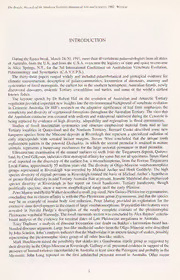
Introduction PDF
Preview Introduction
The Beagle, Records of the Northern Territory Museum of Arts and Sciences, 1992 9(l):i-iv INTRODUCTION During the Easter break, March 28-30,1991, more than 40 vertebrate palaeontologists from all states of Australia, from the U.K. and from the U.S.A. overcame the logistics of time and space to convene in Alice Springs, N.T., for the 3rd International Conference on Australasian Vertebrate Evolution, Palaeontology and Systematics (C.A.V.E.P.S.). The thirty-three papers ranged widely and included palaeobotanical and geological evidence for climatic reconstruction, description of palaeocommunities, locomotion of dinosaurs, anatomy and systematics of fossil marsupials, the earliest bat in the southern hemisphere, Australian lizards, newly discovered dinosaurs, endemic Tertiary crocodilians and turtles, and some of the world’s earliest known fishes. The keynote speech by Dr Robert Hill on the evolution of Australian and Antarctic Tertiary vegetation provided important new insights into the environmental background of vertebrate evolution in Cenozoic Australia. Dr Hill’s research on the adapative significance of leaf fomi emphasizes the complexity and diversity of vegetational formations throughout the Australian Tertiary. The view that the Australian continent was covered with uniform and widespread rainforest during the Cenozoic is being replaced by evidence of high diversity, adaptability and regionalism in floral communities. Studies of fossil mammalian systematics and structure emphasized material from mid to late Tertiary localities in Queensland and the Northern Territory. Bernard Cooke described some new kangaroo species from the Miocene deposits at Riversleigh that represent a specialized radiation of early macropodids with serrated incisor margins. Steven Wroe concluded that the unique tooth replacement pattern in the potoroid Ekaliadeta. in which the second premolar is retained in mature animals, repre.sents a buttressing mechanism for the large sectorial permanent or third premolar. Ullrastructure examination of the enamel surfaces of teeth from the Tingamarra deposit, Queens¬ land, by Coral Gilkeson, indictates clear marsupial affinity for some, but not all specimens. Susan Hand et al. reported on the discovery of the earliest bat, a micrtxrhiropteran, from the Eocene Tingamarra Local Fauna, approximately 55 million years old. The diversity of Oligo-Miocene vombatomorphian groups represented at Riversleigh was recorded by Michael Archer and Henk Godlhelp. The high species diversity of ringtail possums at Riversleigh formed the basis of Michael Archer’s hypothesis of greater floral diversity in mid Tertiary Australia than at present. Jeanette Muirhead also emphasized species diversity at Riversleigh in her report on fossil bandicoots. Tertiary bandicoots, though prolifically speciose, show a narrow morphological range until the early Pliocene. Peter Murray and Phillip Walker described a small, pig-sized, New Guinea Pleistocene zygomaturine, concluding that its closest affinity is with the Plio-Pleistocene genus Zygomaturits, and that the species may be an example of insular body size reduction. Peter Murray provided an explanation for the extensive sinus developments in the crania of large vombatomorphians. Wynyardiid-like features were revealed in Neville Pledge’s description of the nearly complete cranium of the plesiomorphic Pleistocene vombatid Warenclja. The fossil mammals section was concluded by Alex Baynes’ criteria- based analysis of the evidence for terminal dates of Late Pleistocene megafauna in Australia. Tony Thulbom’s analysis of dinosaur locomotion cast doubt on Bakker’s locomotion-based hot- blooded dinosaur argument. Large boa-like madtsoiid snakes from the Oligo-Miocene were described by John Scanlon. John’s analysis indicates that the Madtsoiidae is an ancient lineage of snakes, pos.sibly representing the plesiomorphic sister group of all other boa-like snakes. Mark Hutchinson raised the possibility that skinks are a Gondwanan reptile group as suggested by their diversity in the Oligo-Miocene at Riversleigh. Gaffney et al. presented evidence in support of the presence of homed tortoises (meiolaniids) in Australia at least since the Paleogene and probably in the Mesozoic. John Long reported on the first azhdarchid pterosaur record in Australia. Other recent 1
